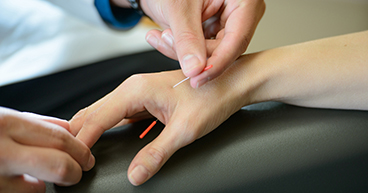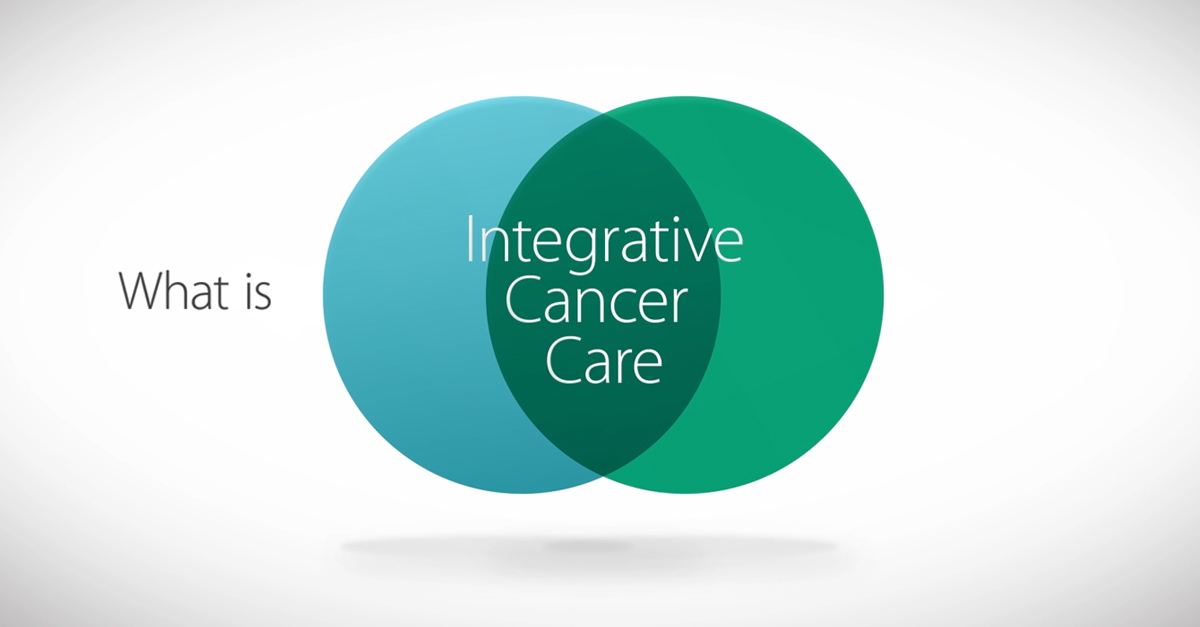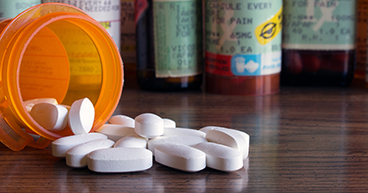
The physical side effects of cancer are often hard to avoid. Whether it’s the buildup of scar tissue from surgery or hair loss caused by chemotherapy, most cancer patients experience some form of adverse physical reaction to the disease itself or the therapies designed to fight it. Helping patients manage and reduce side effects may go a long way in avoiding treatment delays or interruptions and improving their quality of life. Still, some patients worry that managing side effects will mean adding one more pill to the list of drugs they have to take each day. But many times, medication isn’t necessary. In fact, simple lifestyle-related changes like eating a specific diet or adding light exercise to the daily routine may help significantly.
“Patients don’t want to be on a lot of medications, typically. We listen to patients to understand what they like to do, what might be keeping them from enjoying life, and what management options they might be comfortable with. It’s weighing risks and benefits, pros and cons.” – Imran Shariff, MD, Supportive Care Physician at CTCA Philadelphia
Here are some common physical side effects cancer patients face and tips for managing them:
Hair loss
Some cancer treatments may cause you to lose some or all of your hair (alopecia). For instance, while chemotherapy attacks rapidly growing cancer cells, some chemotherapy drugs may also damage healthy cells, such as hair follicles. Hair loss may include scalp, facial, axillary, pubic and body hair. Radiation therapy may cause hair loss in the treated area.
Some people experience hair loss, and others do not, or they experience hair loss differently even when undergoing the same treatment. If hair loss does occur, it usually begins within two weeks of starting treatment like chemotherapy and gets worse one to two months after the start of therapy.
Fortunately, hair will almost always grow back after treatment is complete. Regrowth usually occurs in six to eight weeks after the therapy ended. It is common for hair to grow back a slightly different color and texture at first.
Tips for dealing with hair loss
- If you decide on a wig or hairpiece, have it ready in advance before hair loss occurs. This way, you can match it to your natural hair color, style and texture.
- Try scarves, caps, turbans or hats as an alternative to wigs and hairpieces, or simply leaving your head uncovered.
- If you have long hair, consider getting a stylish short cut.
- Use a soft-bristle brush and avoid too much brushing or pulling of hair (avoid braiding or placing hair in a pony tail).
- Use mild, gentle shampoos and conditioners. Rinse your hair thoroughly and gently pat it dry to avoid damaging your hair.
- Avoid coloring, perming or relaxing the hair.
- Avoid using hair dryers, electric rollers or curling irons.
- Limit the use of hair clips, barrettes, elastic bands, bobby pins and hair sprays.
- Use sunscreen/sunblock or wear a hat/scarf to protect your scalp from the sun.
- In cold weather, wear a hat/scarf outdoors to prevent loss of body heat.
- Sleep on a satin pillowcase.
Learn more about hair loss and supportive care services that may help.
Pain
During your cancer journey, you may experience pain from the cancer itself, or as a side effect of cancer treatment. Proper pain control is important because the pain may get worse if ignored. Also, when cancer pain is not treated properly, you may be tired, depressed, angry, worried, lonely or stressed. Pain may also slow your recovery from cancer treatment.
To determine an appropriate pain control plan for you, your doctor may ask you to describe your pain, or rate it on a scale from 0 to 10, where 0 means no pain and 10 means the worst pain you can imagine.
Cancer pain may be treated with medication (e.g., analgesics, also called “pharmacological pain relief”), without medication (e.g., non-drug treatments, also called “noninvasive measures”), with other treatments (e.g., surgery, radiation therapy, nerve blocks) or with a combination of methods.
Tips for managing cancer-related pain
- Work with your doctor to develop a pain management plan that meets your needs, including how to take your medication and other methods you can use to alleviate your pain.
- Notify your doctor right away if you have any new pain, if your pain is getting worse, or if your pain medication is not working.
- Take your pain medication on a regular schedule as instructed by your doctor. Do not skip doses of your medication, or wait for the pain to get worse before taking your medication.
- Take your long-acting pain medication as prescribed even when you are not feeling the pain. Once you feel pain, it is more difficult to get it under control.
- Let your doctor know if you experience side effects of pain medication, such as constipation, nausea and vomiting, or drowsiness.
- To help your doctor determine the right pain control methods for you, keep a record or a journal to track the details of your pain, such as:
- The location(s) of your pain
- How your pain feels (Does it ache, burn or tingle? Is it sharp, dull, throbbing or steady?)
- What makes your pain feel better or worse
- Changes in pain in response to certain activities, times of day, etc.
Learn more about pain and supportive care services that may help.
Fatigue/weakness
If you are fighting cancer, chances are you have experienced fatigue and/or weakness at some point. Cancer-related fatigue is an unusual and persistent lack of energy or sense of tiredness and exhaustion related to cancer or its treatment. If you are suffering from cancer-related fatigue, even simple activities, such as talking on the telephone, shopping for groceries or walking across a room can seem like too much.
Treatment for cancer-related fatigue requires understanding the underlying cause(s) of the condition and learning ways to manage it. Your doctor may ask you to describe your fatigue on a 0-10 scale. You may also receive a physical examination and additional tests, such as blood work. Your doctor will likely consider other factors, including the type and stage of cancer, your treatment history, current medications, diet, sleep and/or rest patterns, psychological profile, general health and other factors (e.g., anemia, breathing problems, decreased muscle strength, etc.).
Tips for reducing cancer-related fatigue
- Try to plan out your day’s activities in advance and keep a regular and reasonable daily routine.
- Prioritize your activities so you use your energy on the activities most important to you. Do shorter versions of your usual activities.
- Spread your activities throughout the day during times when you feel best and take rest breaks in between activities.
- Take consistent, short naps (30 minutes each) throughout the day, rather than one long nap. Try not to nap too late in the afternoon.
- If you can, rest before you become fatigued and follow a nap with an activity or light exercise.
- Follow a well-balanced diet (high in protein and carbohydrates, and low in sugar) and drink plenty of fluids to avoid dehydration. Avoid heavy meals, alcohol or caffeine late in the day.
- Get regular, light exercise (e.g., a 15-minute walk three times a week).
- Establish a regular sleeping routine with regular bedtimes (go to sleep and wake up at the same time).
- Modify your home environment by placing items within easy reach to avoid multiple trips up and down stairs or in and out of rooms.
- Delegate household chores and tasks to others.
- Use good body mechanics while working. Sit while doing a task. Push instead of carry. An occupational therapist can help you with additional ways to conserve energy.
- Try using relaxation techniques to combat stress (e.g., deep breathing, meditation, visualization, music therapy, massage).
- Adjust your work schedule to take advantage of your peak energy times.
- Share your feelings with others (e.g., family, friends, support groups, a professional counselor).
- Keep track of your fatigue from day to day and share this information with your doctor.
Learn more about fatigue and supportive care services that may help.
Sleep disturbances
Many people living with cancer commonly experience sleep disturbances or insomnia (chronic sleeplessness). Certain cancer treatments and medications may cause side effects like nausea, pain, anxiety and depression, that can contribute to insomnia.
Insomnia can make it difficult to fall asleep and stay asleep. For instance, you may awaken multiple times during the night, or early in the morning, and not be able to get back to sleep. This condition can lead to fatigue, memory and concentration problems, and mood disturbances.
Treatment for insomnia may include pharmacological approaches, such as pain medication, as well as non-pharmacological approaches.
Tips for managing sleep disturbances/insomnia
- Sleep in a dark, cool, quiet room. Sleep on a comfortable bed with clean, dry sheets, adequate bed covers for warmth and pillows for support.
- Avoid too much fluid intake before bedtime to avoid waking up frequently to use the bathroom.
- Wear loose, soft, comfortable clothes to bed.
- If you can’t fall asleep, or if you waken and can’t fall back to sleep after 20 minutes, leave the bedroom and return when sleepy.
- Do not watch TV, eat or read in bed. Use the bedroom for sleep and sexual activities only.
- Try to maintain a regular sleep schedule by going to sleep and waking up at the same time each day.
- Develop a pre-bedtime ritual to relax and get yourself ready for sleep.
- Do not take long naps (more than 30 minutes) during the day or nap too late in the afternoon (after 3 p.m.).
- Move your clock away from your bed so you can avoid looking at it during the night.
- Try a high-protein snack two hours before bedtime (e.g., milk, turkey, etc.).
- Take a warm bath or have a warm glass of milk or cup of chamomile tea at bedtime.
- Read a book or listen to music to relax before going to bed.
- Avoid heavy meals, alcohol or caffeine late in the day (four to six hours before bedtime).
- Exercise regularly (e.g., 15-20 minutes three times a week).
- During the day, try different ways to reduce stress, such as relaxation techniques, deep breathing, stretching, meditation and massage.
Swelling/lymphedema
Cancer and its treatment, such as surgery to remove lymph nodes (common for breast cancer), can sometimes change, block or interrupt the flow of lymph fluid through the lymphatic system. When excess lymphatic fluid collects in the interstitial tissue, it is called lymphedema. This abnormal build-up of fluid causes swelling in specific areas of the body, most often in the arms or legs.
Early diagnosis and treatment for lymphedema is important to help reduce symptoms and prevent the condition from progressing. Sentinel lymph node biopsy attempts to reduce the number of lymph nodes that need to be removed for biopsy.
In addition, lymphedema treatment may include skin care, manual lymph drainage, gentle massage, and light exercises to help stimulate the lymphatic system. Wearing compression bandages, pumps or garments (e.g., sleeves, stockings) may also help prevent additional fluid from accumulating in the tissue. In addition, medications may help reduce inflammation, prevent blood clots and treat infections.
Tips for managing lymphedema
- Tell your doctor if you experience symptoms. Monitor your activities to determine whether a particular activity causes the condition to worsen.
- Try to keep the affected arm or leg above the level of the heart when possible. Avoid stretching, pulling or holding your arm over your head for extended periods of time.
- Check all areas of the arms and legs daily for signs of infection, which may include a fever over 100 degrees Fahrenheit, chills, redness, pain, tenderness, heat, swelling and/or rash. Immediately report warning signs of infection to your doctor.
- Wear well-fitting compression garments that are carefully fitted and monitored to apply the right pressure while making sure it is not too tight near the top.
- Protect the affected area from scratches, sores, burns, insect bites or other irritations or injuries.
- Avoid exposure to extreme cold or prolonged heat, which can be associated with increased fluid build-up, swelling or chapping/chafing of skin.
- Avoid muscle strain, vigorous activities, repetitive movements, heavy lifting or pulling of the affected limb. Also, avoid prolonged lying, standing, sitting or crossing the legs on the affected side.
- If possible, try to avoid having blood pressure taken, blood drawn or injections given on the affected side.
- Try to maintain a healthy weight, since being overweight may increase the chances of swelling. Avoid foods high in salt and fat. Gradually increase the intensity of activity and avoid fatiguing the muscles of the affected area, which may cause injury or additional fluid accumulation.
- Wear comfortable, well-fitting clothing and shoes. Avoid socks, hosiery or undergarments with tight elastic bands.
- Wear loose watches, jewelry and gloves.
- Women should wear well-fitted bras, and bra straps should not be too tight.
- Consult with a rehabilitation therapist trained in managing lymphedema.
Learn more about lymphedema and supportive care services that may help.
Talking to patients about why side effect management is necessary is a large part of a cancer doctor’s role, Dr. Shariff says. “It’s important to treat cancer-related side effects because, sometimes, patients will choose to stop treatment because of debilitating symptoms, or will be forced to stop because they’re too weak to continue,” he says. “So, a lot of what we’re doing is educating patients on the importance of maintaining a good quality of life during cancer treatment, and letting them know that if we can manage their symptoms without medication, great, but if not, we might need to add something, but it may not be forever.”



